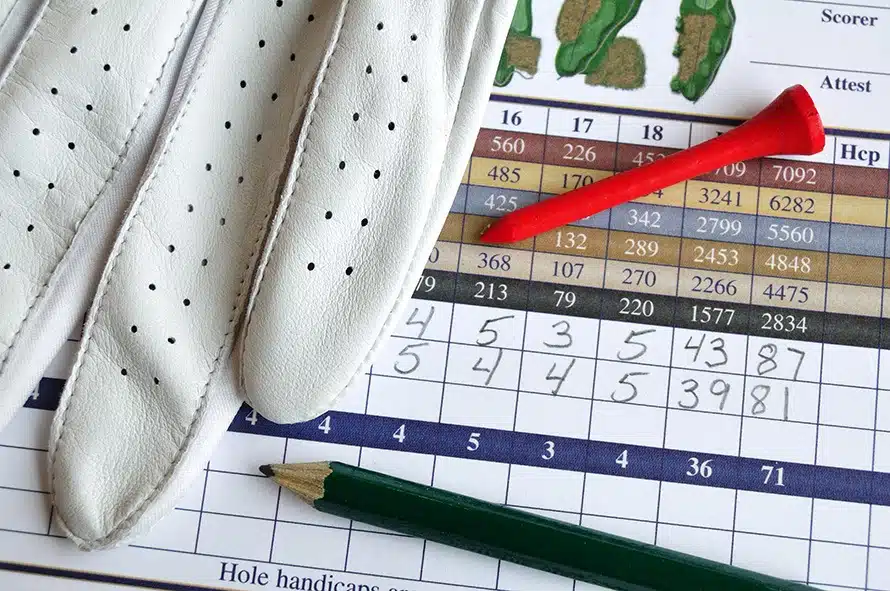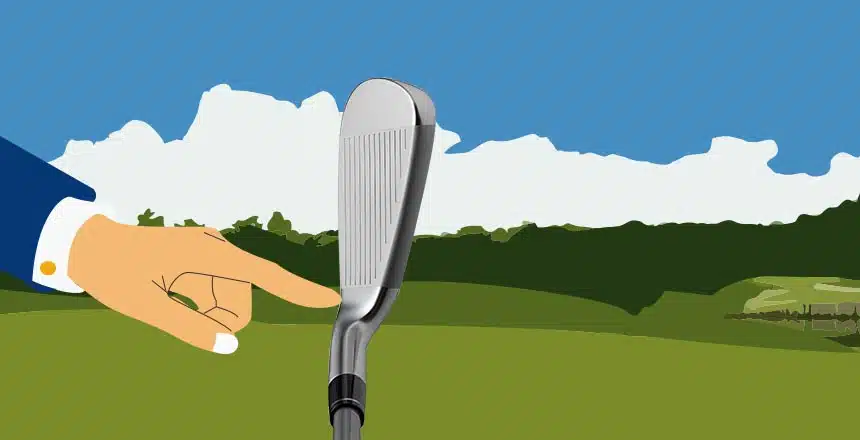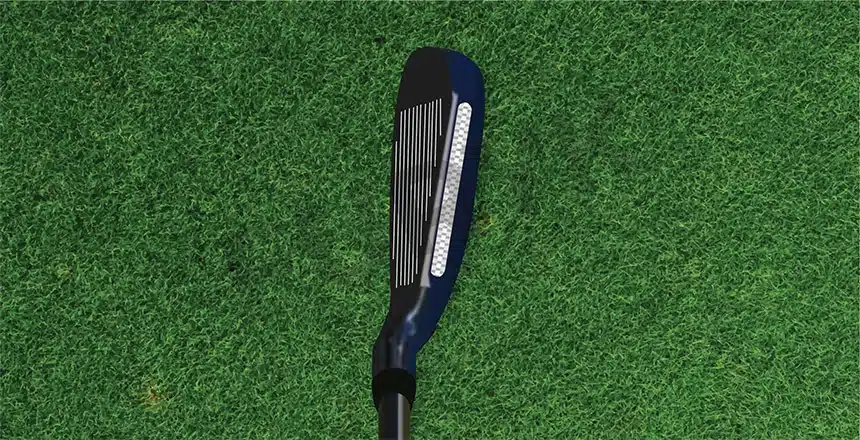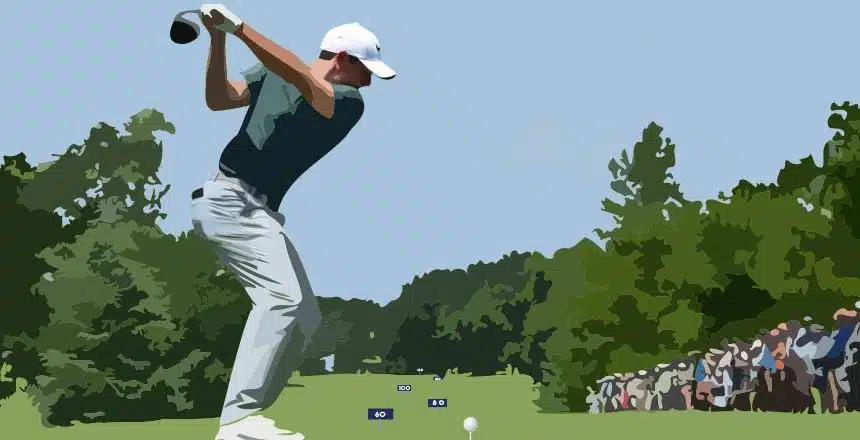The game of golf in itself can be quite complicated to understand if you’re a beginner. So it only seems logical for questions like what is a golf handicap and how does golf handicap system work to be loaded.
Because answering them, much like understanding the different aspects involved in a single round of golf, means breaking it down into comprehensible concepts.
And you might think that golf handicap is not really an important topic of discussion since just 20% of the golfing population has a legitimate handicap. But then that’s not the right approach nor is it a valid deduction. And only when you understand the whole concept of golf handicap will you be able to get rid of all that confusion.
In This Post
- What is Golf Handicap? What Does ‘Golf Handicap’ Mean?
- How to Get A Handicap In Golf
- How to Calculate Golf Handicap
- Average Golf Handicap
- Improving Golf Handicap – 5 Most Effective Strategies
- All Frequently Asked Questions About Golf Handicap
- What is A Good and Bad Handicap?
- Why Do I Need to Know My Golf Handicap?
- When Does Your Handicap Get Updated?
- What is the Maximum Golf Handicap?
- What is the Golf Handicap for Beginners?
- How Much Does Golf Handicap Cost?
- What Does Handicap Line Mean On Golf Scorecard?
- What is My Golf Handicap If I Shoot 100?
- Everything Important Is Covered!
What is Golf Handicap? What Does ‘Golf Handicap’ Mean?

Some golf irons are better suited for mid-handicap golfers and not the others. But then why and how does this difference exist – newcomers are bound to get confused. So here’s an actual explanation of a golf handicap.
According to the USGTF (United States Golf Teachers Federation), a golf handicap is how well you currently play a single round of golf. This is an actual measurement, with numbers. So the lower your handicap number, the better your current playing ability. This handicap number is essentially the number of strokes you should be playing below or above par.
But then a golf handicap depends on how difficult the course is on which you’re playing. For men, the max. handicap is 36. And for women, the highest handicap is 40. Now, obviously, your golf handicap is actually based on your most recent round of golf. So it can change later as you begin to play more and more rounds of golf.
Another topic that helps with the definition of golf handicap is Fair Play. The USGTF has brought fair play into the mix because it’s only reasonable for all golfers, no matter their skills, to be able to compete together. And this ‘fair chance’ is brought about by the differences in the players’ varying handicap levels.
Let me explain that with the help of an example:
If I’m a 10-handicap golfer and you’re a 15-handicap golfer, then I give you 5 strokes before our round of golf begins. Yes, sort of like an advantage of an early start!
And when talking about stroke play, if I shoot the lowest (lowest net score, which is my handicap subtracted by my total strikes), then I win the round.
Now, what about the golf handicap numbers you see on the scorecard? These denote the number of strokes low handicappers should offer high handicappers during match play.
Another instance – when a 6-handicap golfer faces a 12-handicap golfer, each hole gets one handicap number (from 1 to 18). So far, so good? Then the lower handicapper gives the higher handicapper the advantage of 1 stroke per 6 holes (holes for which the handicap is 1, 2, 3, 4, 5, and 6).
How to Get A Handicap In Golf
If you think it’s a complicated undertaking, getting your golf handicap, then you surely haven’t been guided the right way. Just head on to the USGA website here and register online. Or you could also sign up at your own golf course. If a member, then you get charged a small amount, which is added to your yearly membership. And if not a member, then the annual fee is about $30-$40.
Once the application gets accepted, the GHIN number you receive lets you post scores online (or have others post them on your behalf).
Now comes the most important part…
How to Calculate Golf Handicap
Firstly, are you even breaking 100? If your answer is NO, no sense in calculating or even needing a handicap. But if you indeed are able to break 100 now, then here’s how to go about establishing your golf handicap…
1. Keep Score (but no cheating!)
Keeping your golf score is a must if you want to get serious about calculating a formal handicap. But then no cheating allowed nor is it okay to fudge the rules (take the penalties, count missed putts, etc). Start by tracking your shots, all of them of course.
Another golfer is required for technically counting your scores to determine your handicap. So there’s no way to cheat – no stretching the truth and hitting fewer shots per round.
Speaking of which, about 15 to 20 rounds of golf are more than enough. But 10 rounds at least are typically required to sign you up. And it would be more preferable if these were played on different golf courses (preferable, not mandatory though).
2. Adjust the Score
Wait, what!? If you can adjust your score, then how are you not going to cheat along the way?
Let’s assume your handicap score is 13, so do you really need to card that number? No, not necessarily because USGA, thankfully, gives you the highest number cap that you get to card for each hole. And here’s how that works…
- If your handicap is 40 or higher, you can cap a max. score of 10.
- If your handicap is between 30 and 39, you can cap a max. score of 9.
- If your handicap is between 20 and 29, you can cap a max. score of 8.
- If your handicap is between 10 and 19, you can cap a max. score of 7.
- If your handicap is 9 or lower, you can cap a max. score of double-bogey.
3. Check the Course and Slope Rating
Not every golf course is equally easy or difficult to play. A higher rating (slope and course) suggests that that particular course is more challenging to play if you’re a zero-handicap, scratch golfer.
So please don’t forget to take this factor into account as well because your local club is in no way the same in comparison to, for instance, a highly complex turf like that of Pebble Beach.
4. Calculate the Handicap Differential
Your each (adjusted) handicap score is different, so here’s how to calculate your handicap differential for every score…
The Formula:
Golf course adjusted total score-rating (X 113) divided by slope ratings of the course.
Your scores on any regular golf course under regular playing conditions give you the course rating. And slope rating means the 113 rating for a golf course that is based on basic difficulty.
Now you choose the lowest or best handicap differential. And in case of over 20 scores recorded by you, the scores used for calculation will be the top 10 differentials from your most current 20 scores.
With the top 10 differentials you have with you at this point, your next step is calculating the average based on the lowest 3. And if you’re working with 15 handicap differentials, then get your average not for the lowest 3 but the lowest 6.
Then you multiply that handicap differential average by 0.96 or 96%.
And finally, refrain from rounding off that figure. According to USGA rules, the max. handicap index number is 40.4 for female golfers and 36.4 for men (18 holes). On a 9-hole golf course, however, that should be 20.2 for the ladies and 18.2 for male golfers. So if the average you achieve is 13.196 (just an example), truncate the value to 13.1.
And one last step, calculate the course handicap. What’s the course handicap – the strokes you get to play on that golf course.
Golf course handicap equals your handicap calculation (for example, that’s 12.7) multiplied by course slope rating (115) divided by 113.
12.7 into 115 divided by 113 gives you 12.92, which is equal to 13 course handicap.
Average Golf Handicap
Men vs. Women
When you break it down by gender, men have an average handicap of 13.7 and women 27.3.
Young vs. Old
What is the average by age is also important to note…
- Junior golfers – 150-180 handicap index
- Teen golfers – 90-180 handicap index
- Young golfers – 80-90 handicap index
- Senior golfers – 91-94 handicap index
Improving Golf Handicap – 5 Most Effective Strategies
It’s only a part of the game of golf to want to improve your handicap level, no matter your goal. And this surely is easier said than done because being stuck with that same handicap index for years sometimes is not so uncommon. But then when it has to change, you might do whatever it takes to lower your handicap and, ultimately, your golf scores too.
Practice From 100 Yards and Below
When almost half of your shots in a single round of golf are hit from within 100 yards (known as the scoring range), you have to make it a point to practice from the same distance as well. And this means acing your short game performance (wedge shots, chips, and putts).
Practicing from 100 yards and below is actually very effective when it comes to quickly lowering your handicap. You can divide these 100 yards into increments of 25-yards each. So that gives you 25-yard, 50-yard, 75-yard, and 100-yard distances to work out. This means practicing your quarter, half, 3/4, and full backswing (keeping a smooth tempo in mind).
And as far as putting and chipping are concerned, practice from a broad range of lies, positions, and slopes.
Improve Your Swing
A well-balanced golf swing is crucial when it comes to making solid contact with the golf ball. And for that, place some extra weight on the back foot during your swing for additional power. 60-percent weight in the back foot and 40-percent weight in the front.
And once contact is made with the ball, complete the follow-through movement too.
To be more specific, I’d like to talk about the downswing here just for a second. During the downswing, shallowing the golf club actually helps. But then this is easier said than done of course. However, it’s still something that needs attention if you want to not only lower that handicap but also prevent common mishaps like hitting slices.
The most practical approach to shallowing out your downswing – external rotation of the trail shoulder. What might also help – bow the leading wrist to shallow out the club as well as square the clubface at the right time; all I’m seeing here is a solid impact position.
See also (Golf Setup, Golf Swing Sequence)
Get A Proper Grip
Your grip is the only point of contact you have with your golf club. As for which grip actually works in your favor for lowering golf handicap (For more on gripping, click here) – interlocking two fingers or simply just placing your pinky finger over your pointer finger at the time of swinging.
Yet another preferred grip is one that forms the letter “V” using the pointer finger and thumb on the non-leading hand. While the dominant hand makes another “V” right under the first one along the shaft.
The grip also includes glove, the right kind of golf glove. Wear this on the non-leading hand to play your shots without running the risk of the club literally slipping away from you in case your palms are sweaty or if it’s raining.
Buy the Right Golf Equipment
Let’s start with golf clubs – these drivers here are purposely designed to be more forgiving for high handicappers and beginners alike. This just means the club shaft is soft, lightweight, and flexible to help you bomb off the tee even with your slow swing speed and/or high handicap.
As for golf balls, check their compression rating. Those with a high handicap and slow swing speed choose low compression golf balls (compression rating of 80 or below). 100 compression rating, on the other hand, works flawlessly for faster swingers and lower handicappers.
Practice Purposefully and Under Pressure
If you genuinely want to lower your handicap, then quite heading to the driving range to pound one golf ball after another aimlessly (or just because you wish to out-perform your golfing mates). Instead, practice the right way, which is keeping a play-under-pressure mindset.
Imagine a scenario – there’s a crowd watching you play. On the left side of the fairway, there’s water. And toward the right, you’ve got out of bounds. Then choose any target along the middle section of the fairway. Now aim for that small target with the finest shot you can produce.
When I say practice purposefully, I mean practice to hit the same golf club multiple times BUT with a target. So you’re repeatedly trying to hit that target in more than just one way. You can also aim for draws and fades, along with finally just hitting the shot straight toward the target without any curves.
All Frequently Asked Questions About Golf Handicap
What is A Good and Bad Handicap?
The good and bad actually depend on your goal. If breaking 100 is your priority, then a 20 golf handicap is good indeed. On the other hand, if becoming a scratch (that means zero-handicap) golfer is what you’re aiming for, then 20 is surely bad.
Generally speaking though, breaking 90 is good enough because it means you get to play golf with almost everyone without worrying about slowing them down.
Why Do I Need to Know My Golf Handicap?
As far as my professional expertise is concerned, I don’t think handicap is necessary unless you want to improve or compete. That way, if you have a handicap, it becomes so much easier to, first of all, keep track of your progress. And second of all, a handicap is useful when competing since it balances out the playing field, in terms of the number of strokes you get.
When Does Your Handicap Get Updated?
Every 2 weeks (the 1st of the month and the 15th of the same month) – that’s when USGA updates the golf handicap. They email you the updated card on both the dates; just make sure you sign up for their email service.
Add valid scores as often as you can BEFORE the 1st and 15th (before midnight).
What is the Maximum Golf Handicap?
The max. golf handicap, according to USGA’s handicap system, for men is 36.4 and for women is 40.4. But then you don’t need to concern yourself with the whole concept of handicap until you start breaking 100.
What is the Golf Handicap for Beginners?
Honestly, I don’t think I’ve ever come across a newbie who can break 100. And even if I did, I would’ve told that poor fellow to not waste his money on getting a golf handicap until he/she starts to break 100.
But then roughly speaking, a beginner golf handicap would be 28.
How Much Does Golf Handicap Cost?
At any private club, members often don’t need to pay extra; golf handicap ($30-$40) is a part of their annual membership. Even the renewal part is pretty much covered by the golf club.
But then if you’re getting it done online, select automatic renewal. Otherwise, your golf handicap freezes but doesn’t get deleted. And you can always sign up once again in case you forget to renew or change cards. So you keep all your scores and when active, you get to post them again.
What Does Handicap Line Mean On Golf Scorecard?
Holes on a scorecard are ranked from 1 to 18. Now comes the line known as HDCP (handicap). And what it does is rates how difficult each hole is – 18 being the easiest, 1 being the hardest.
At such times, if a 10-handicap golfer and a 22-handicap golfer are playing a match, then the less competent one gets 12 strokes (that’s 1 stroke each for the 12 most difficult holes).
What is My Golf Handicap If I Shoot 100?
If you’re shooting 100, on an 18-hole course, you can calculate your handicap this way…
100 minus 72 equals 28. So 28 is your golf handicap.
Everything Important Is Covered!
Here’s the thing – there’s just no way you can lower your handicap and improve your golf game if you don’t practice and play more often. Another thing is that you don’t necessarily need a handicap in the first place if you aren’t yet breaking 100.
As for how this whole system of golf handicap works and affects performance, pretty much all of that is discussed in this post. It’s only a number that represents your playing ability, so you can compare, compete, and even monitor your progress.






First off, I have always admired your professional demeanor on and off the course. I saw you play (any PRO really) for the first time ever at a pro event in Westlake Village World Challenge in 2012. Awesome.
So I find myself in between a senior wanting more forgiveness in equipment and learning (actually practicing) shot shaping. Honestly I am better at fades then draws. LOL. My Cobra Fly Z’s are 10 years old and looking for game improvement clubs. Yes, indeed I want to improve. I am 70 years old with a 17HC and swing speed of 80. So you shed some light for me, that high MOI may not be the equipment I am looking for. Maybe I am a dreamer? Its always a challenge, either way. Thank you